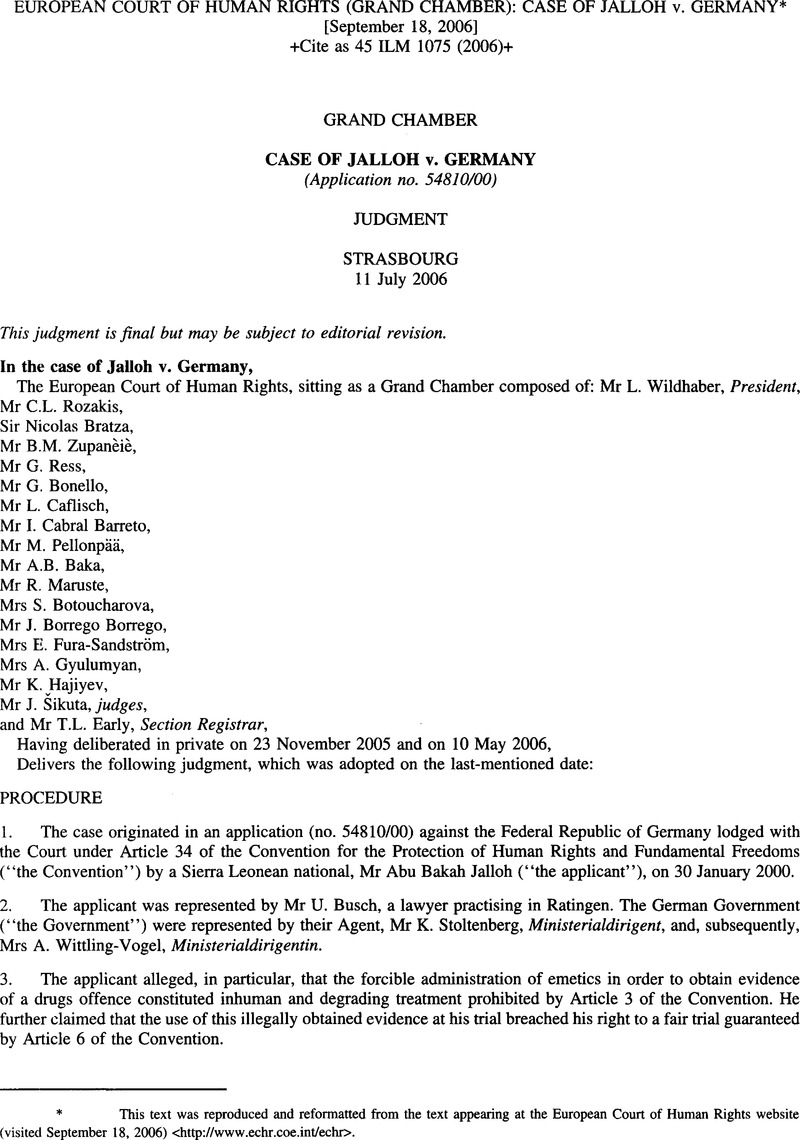Published online by Cambridge University Press: 27 February 2017

* This text was reproduced and reformatted from the text appearing at the European Court of Human Rights website (visited September 18, 2006) <http://www.echr.coe.int/echr>.
1 Convention against Torture and Other Cruel, Inhuman or Degrading Treatment or Punishment, G.A. res. 39/46, [annex, 39 U.N. GAOR Supp. (No. 51) at 197, U.N. Doc. A/39/51 (1984)], entered into force June 26,1987. The U.N. Committee against torture has urged Germany to adopt article 1 of U.N.C.A.T. as a definition of the offence of torture in its own substantive criminal law. Germany was urged, too, to apply strictly the rule excluding all evidence derived from torture from the cognizance of the deciding judges. The failure to follow these early warnings of the U.N. monitoring body contributed to the emergence of the practice that is the subject matter of this case. See,Concluding observations of the Committee against Torture: Germany. 11/05/98., A/53/44, paras.179-195. (Concluding Observations/Comments), paras. 185 and 193. In the context of the case at hand it may also be indicative that the International Covenant on Civil and Political Rights, 1966, in its Article 7 treats torture on a par with medical or scientific experimentation: “No one shall be subjected to torture or to cruel, inhuman or degrading treatment or punishment. In particular, no one shall be subjected without his free consent to medical or scientific experimentation. ‘
2 ''To require a threshold showing of an ‘objective’ injury, the sort of thing that might reveal itself on an x-ray, or in missing teeth, or in a bruised and battered physical appearance, would confer immunity from claims of deliberate indifference on sadistic guards, since it is possible to inflict substantial and prolonged pain without leaving any ‘objective’ traces on the body of the victim” (Judge Posner in Cooper v. Casey, 97 F.3d 914, 917 (7th Cir. 1996) (citations omitted)). Furthermore, substantial and prolonged pain can be psychological as well as physical. “[M]ental torture is not an oxymoron, and has been held or assumed in a number of prisoner cases … to be actionable as cruel and unusual punishment'’ (Judge Posner in Thomas v. Farley, 31 F.3d 557, 559 (7th Cir. 1994)). In a case involving cross-gender body searches it has been held that “severe psychological injury and emotional pain and suffering” counted as “infliction of pain” under the Eighth Amendment (Judge O'Scannlain in Jordan v. Gardner, 986 F.2d 1521, 1525, 1528 (9th Cir. 1992)). “Many things beating with a rubber truncheon, water torture, electric shock, incessant noise, reruns of ‘Space 1999’ - may cause agony as they occur yet leave no enduring injury. The state is not free to inflict such pains without cause just so long as it is careful to leave no marks” (Judge Easterbrook in Williams v. Boles, 841 F.2d 181,183 (7th Cir. 1988)). At http://www.yale.edu/lawweb/avalon/diana/harris/110998-2.ht.
3 U.N. C.A.T, Article 16 : “1. Each State Party shall undertake to prevent in any territory under its jurisdiction other acts of cruel, inhuman or degrading treatment or punishment which do not amount to torture as defined in article 1, when such acts are committed by or at the instigation of or with the consent or acquiescence of a public official or other person acting in an official capacity. In particular, the obligations contained in articles 10, 11, 12 and 13 shall apply with the substitution for references to torture of references to other forms of cruel, inhuman or degrading treatment or punishment.” [Emphasis added.]
4 At http://news.bbc.co.Uk/2/hi/americas/4569626.stm.
5 Rochin v. California, 342 U.S. 165 (1952) at http:// caselaw.lp.findlaw.com/cgi-bin/getcase.pl?navby=case&court=us&vol=342&invol= 165
6 Fifth Amendment to the United States Constitution: ‘ No person shall be […] compelled in any criminal case to be a witness against himself.
7 U.N. C.A.T., Article 15: Each State Party shall ensure that any statement which is established to have been made as a result of torture shall not be invoked as evidence in any proceedings, except against a person accused of torture as evidence that the statement was made. [Emphasis added.]
8 Wigmore on Evidence (McNaughton rev. 1961) Vol. 8, p. 318 [Emphasis added.]
9 See,Rochin v. California, 342 U.S. 165 at 172 (1952): “[W]e are compelled to conclude that the proceedings by which this conviction was obtained do more than offend some fastidious squeamishness or private sentimentalism about combating crime too energetically. This is conduct that shocks the conscience. Illegally breaking into the privacy of the petitioner, the struggle to open his mouth and remove what was there, the forcible extraction of his stomach's contents this course of proceeding by agents of government to obtain evidence is bound to offend even hardened sensibilities. They are methods too close to the rack and the screw to permit of constitutional differentiation.“
10 Thus, although there were indications that larger amounts of drugs were involved, the Court applied the principle of favour defensionis and assumed (“Die Strafkammer geht deshalb zugunsten des Angeklagten davon aus …“) that both at 11.35 and 12.25 the applicant only handed over to the buyer a bubble containing on each occasion 0.15 grams of cocaine. The Court also took into account the fact that the applicant was prevented from selling the bubble of 0.2182 grams. In addition, the sentence reflected the fact that the applicant had no criminal record in Germany and that during the one year period which had elapsed between the applicant's release from pre-trial detention and the conviction now under discussion he had not been connected with any criminal activities. In the light of the judgment, one may safely assume that the kind of behaviour which the police observed the applicant engage in could, in the case of another person, easily have led to a more severe punishment.
11 Judge Sikuta considered that the matter should be dealt with exclusively under Article 3. Assuming that a separate issue arises under Article 8, he agrees with the reasoning of this dissenting opinion.